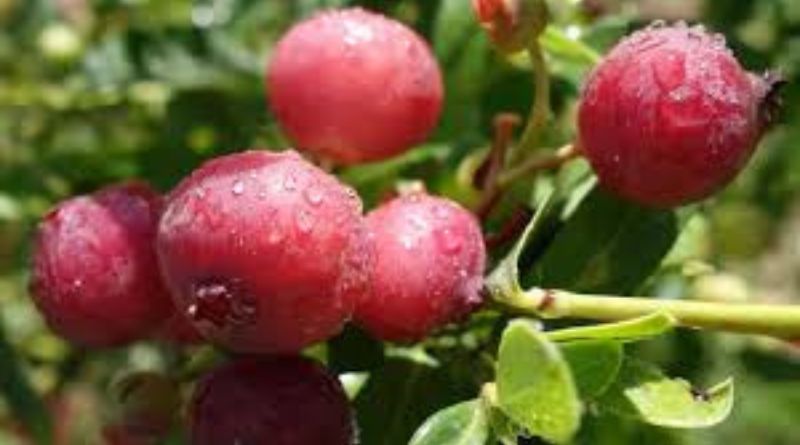The Pink Lemonade Blueberry Plant is a beautiful and unique variation of the popular blueberry bush, known for its striking pink berries and deliciously sweet flavor. Unlike the traditional blue blueberries we are accustomed to, this cultivar adds a pop of color to your garden while offering a distinct and flavorful twist on a beloved fruit. Whether you’re a seasoned gardener or a beginner, the Pink Lemonade Blueberry Plant is an exciting addition to any garden or patio.
In this article, we’ll explore everything you need to know about the Pink Lemonade Blueberry Plant: its origin, characteristics, growing requirements, care tips, and common uses. We’ll also answer some frequently asked questions to help ensure your plant thrives and produces an abundance of colorful and tasty berries.
Table of Contents
What is the Pink Lemonade Blueberry Plant?
The Pink Lemonade Blueberry Plant is a variety of blueberry (scientifically known as Vaccinium corymbosum) that produces vibrant pink berries rather than the traditional blue ones. This cultivar was developed to offer both a visual and a flavor twist on the classic blueberry. While its berries are pink when ripe, they are sweeter and have a more tart, citrus-like flavor compared to regular blueberries.
This variety is a relatively recent introduction in the world of horticulture and is quickly gaining popularity among home gardeners and fruit enthusiasts for its beauty, flavor, and ease of cultivation. The Pink Lemonade Blueberry Plant is a deciduous shrub that not only produces delicious fruit but also offers ornamental value with its bright foliage and beautiful pink berries.
Key Characteristics of the Pink Lemonade Blueberry Plant
The Pink Lemonade Blueberry Plant stands out for several reasons:
1. Unique Berries
The most notable feature of the Pink Lemonade Blueberry Plant is its striking pink berries. These berries ripen in mid to late summer and have a unique, sweet-tart flavor profile that’s less acidic than regular blueberries. The berries start as a pale green color, gradually changing to pink and finally to a deeper rose shade when fully ripe.
2. Compact Growth Habit
This variety of blueberry is known for its compact growth habit. It typically grows to about 18 to 24 inches tall and wide, making it perfect for smaller gardens, containers, or even as a border plant in larger garden beds. Its size allows it to be easily incorporated into various landscape designs or grown in pots on a patio or balcony.
3. Beautiful Foliage
The foliage of the Pink Lemonade Blueberry Plant is another attractive feature. It has bright green leaves that turn shades of yellow, orange, and red in the fall, offering a stunning visual display. The plant is not just valued for its fruit but also for its ornamental beauty throughout the year.
4. Early to Mid-Summer Harvest
Unlike some blueberry varieties that take longer to mature, the Pink Lemonade Blueberry Plant is an early-season producer. Its berries typically ripen in mid to late summer, which makes it a great option for gardeners who want a quick harvest. The berries are also relatively resistant to disease, which makes them easier to grow compared to some other varieties of blueberries.
5. Cold-Hardy
The Pink Lemonade Blueberry Plant is a cold-hardy variety that can tolerate temperatures as low as USDA hardiness zone 4. This makes it suitable for growing in areas with cold winters, as long as the plant is protected from extreme temperatures during winter months.
Growing the Pink Lemonade Blueberry Plant
Growing the Pink Lemonade Blueberry Plant is relatively simple, as long as you meet its specific needs. Here’s a guide to help you grow this unique and flavorful berry plant in your garden or container.
1. Location
Choose a sunny location for your Pink Lemonade Blueberry Plant. Blueberries thrive in full sunlight, requiring at least 6-8 hours of direct sunlight each day. If you are planting multiple bushes, make sure to space them at least 18-24 inches apart to give each plant room to grow and spread.
2. Soil Requirements
Blueberries prefer acidic soil with a pH between 4.5 and 5.5. Before planting, test the soil’s pH level. If your soil is too alkaline, you may need to amend it with sulfur or other soil acidifiers to create the ideal environment for the Pink Lemonade Blueberry Plant. The soil should also be well-draining to prevent waterlogging, which can lead to root rot.
3. Planting
Plant your Pink Lemonade Blueberry Plant in a hole that is twice as wide as the root ball but no deeper. Gently loosen the roots before placing the plant in the hole and fill it with soil, ensuring the root ball is level with the surrounding soil. Water thoroughly after planting to settle the soil around the roots.
If you are planting multiple blueberry bushes, it’s best to plant at least two different varieties to ensure good cross-pollination. While the Pink Lemonade Blueberry Plant is self-pollinating, having a second blueberry plant nearby can help increase fruit yield.
4. Watering
Blueberries prefer consistently moist but not soggy soil. Water the Pink Lemonade Blueberry Plant regularly, especially during the growing season, but allow the soil to dry out slightly between waterings. Drip irrigation or soaker hoses work well for maintaining even moisture levels.
Avoid overhead watering to prevent water from splashing on the leaves, as this can promote fungal diseases. Mulching around the base of the plant with organic materials like wood chips or pine needles can help retain moisture and keep weeds at bay.
5. Fertilizing
Blueberries are sensitive to fertilizer, so it’s essential to use a fertilizer that is specifically designed for acid-loving plants. A slow-release fertilizer is ideal for the Pink Lemonade Blueberry Plant, and it should be applied in early spring before new growth begins. Avoid using too much nitrogen, as this can lead to excessive leaf growth at the expense of fruit production.
6. Pruning
Pruning the Pink Lemonade Blueberry Plant is important for maintaining its health and shape. Prune the plant in late winter or early spring, before new growth begins. Remove any dead or damaged wood, as well as any branches that are crossing or rubbing against each other. This helps improve airflow and sunlight penetration, which can lead to better fruit production.
7. Harvesting
The berries of the Pink Lemonade Blueberry Plant are typically ready to harvest in mid to late summer, usually around July or August, depending on your growing zone. Harvest the berries when they are fully pink and slightly soft to the touch. The flavor should be sweet with a tart undertone, similar to lemonade.
Pick the berries by gently rolling them off the plant, and enjoy them fresh or use them in jams, desserts, or smoothies. To extend the shelf life, you can freeze the berries for later use.
Common Uses for the Pink Lemonade Blueberry Plant
The Pink Lemonade Blueberry Plant is not only a beautiful addition to your garden, but it also provides versatile uses in the kitchen:
- Fresh Eating: The berries are perfect for eating fresh off the bush. Their unique, sweet-tart flavor is a refreshing treat in the summer months.
- Baking: Use Pink Lemonade Blueberries in muffins, pies, cakes, or other baked goods. Their flavor adds a unique twist to traditional blueberry recipes.
- Preserves and Jams: Make homemade jams, jellies, or preserves with these flavorful berries. They pair well with citrus and other fruits for delicious spreads.
- Smoothies: Add a handful of fresh Pink Lemonade Blueberries to smoothies for a colorful, tangy addition to your drink.
FAQs About the Pink Lemonade Blueberry Plant
1. Is the Pink Lemonade Blueberry Plant easy to grow?
Yes, the Pink Lemonade Blueberry Plant is relatively easy to grow, especially for those familiar with growing blueberries. It requires full sun, acidic soil, and regular watering. It is also quite hardy and adaptable.
2. How can I improve the flavor of my Pink Lemonade Blueberry Plant berries?
The flavor of the berries is influenced by soil conditions, particularly soil pH. Ensure that your soil is acidic (pH 4.5-5.5) and provide adequate water and nutrients. Regular pruning and proper care will also help improve berry yield and flavor.
3. Can I grow the Pink Lemonade Blueberry Plant in a pot?
Yes, the Pink Lemonade Blueberry Plant is ideal for container growing. Choose a large pot with good drainage and fill it with acidic, well-draining soil. Ensure the pot is placed in a sunny location, and water regularly.
4. When should I prune my Pink Lemonade Blueberry Plant?
Prune your Pink Lemonade Blueberry Plant in late winter or early spring before the new growth begins. Remove any dead or damaged wood and thin out the center of the plant to improve air circulation.
5. Is the Pink Lemonade Blueberry Plant self-pollinating?
Yes, the Pink Lemonade Blueberry Plant is self-pollinating, meaning it can produce fruit on its own. However, planting another variety nearby can increase yields due to cross-pollination.
Conclusion
The Pink Lemonade Blueberry Plant is a wonderful and visually striking addition to any garden or patio. With its
unique pink berries, delicious flavor, and ornamental appeal, it’s a must-have for blueberry enthusiasts and gardeners alike. By following the proper care instructions and ensuring your plant has the right growing conditions, you can enjoy a bountiful harvest of sweet and tangy berries year after year. Whether you’re using them fresh, in desserts, or in preserves, the Pink Lemonade Blueberry Plant is sure to be a standout in your garden.



